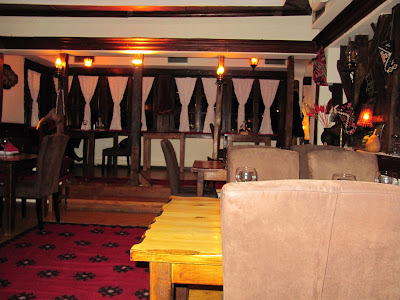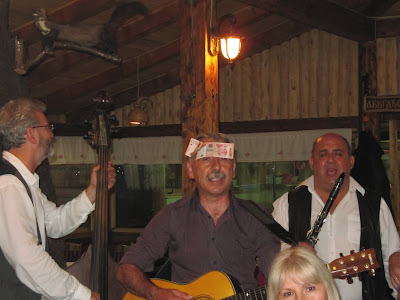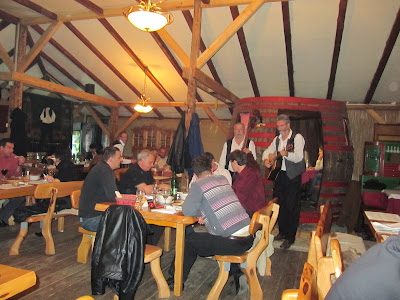Simply put, kafanas are Serbian restaurants. They resemble taverns with their intimate setting and heavy alcohol consumption and they are where you go for any celebration or sit-down meal in the Balkans. There's always some huge celebration, shady people doing business, spontaneous kolo dancing, live starogradska, muzika (old-town music), and loads and loads of undoubtedly delicious food.
The first kafana was opened during the 16th century in what is now Belgrade. Since then their popularity has grown through the Balkans and though there are variants between countries, but the food, music, and atmosphere are more or less the same.
Food in Serbia makes the mouth water and kafanas are no exception. As I mentioned in my post about food, it can be shared or ordered individually in kafanas. You can also ask the waiter to bring a selection of salads, breads, spreads, and meats and you leave it up to him -- I say him because I can't recall having a waitress in a kafana -- to provide an appropriate amount. Even if you order main meals separately there's always bread-breaking and spreads, soups, and salads to share and this keeps on throughout the meal and conversation so it's impossible for you to not feel like your table is a community of sorts.
As incredible as the food is, it takes second place to the atmosphere provided in kafanas.
Tamburaši are the merry men who play the starogradska muzika. They often go table to table taking requests and tips and typically they will play guitars, accordions, tambourines, and various wind and string instruments.



You will see everyone in a kafana mouthing the lyrics or singing along to their songs at some point which continuously fascinates me. Whether they like it or not, each generation has grown up knowing a few hundred of these songs which are played at every single celebration so much so that it becomes involuntary for them to sing and dance. I love how this music hasn't slipped through the cracks or been modified and is still just as present as it was when the older generations grew up.
To this music you dance kolo, a series of coordinated steps in a line or circle of people holding hands taking you forward and back, left and right. There are varieties of kolo but they are all fun to learn and dance and very similar so I've tried to pick up as many as I can through different celebrations.
Though each kafana is unique both the exterior and the interior have remained true to tradition.
Exterior example, usually resembling a house or cabin

The interior of kafanas is like a museum. It showcases Serbia's history through pottery, clothing, cooking materials, embroidery, maps, pictures, paintings, etc.





Cyrillic alphabet decor

My host family went to this kafana known for its lamb for my host father's birthday. The thing is I already have a hard time eating meat because of what had to happen to it to get on my plate so this display of lambchop-reminders wasn't so helpful.

This was at the oldest kafana in Belgrade still around today: Znak Pitanja (question mark) kafana

We've been to three kafanas -- one in Nis, one in Belgrade, and one in Skopje, Macedonia -- that feature Tito, the renowned Yugoslav statesmen of the 20th century. These are filled with quotes, pictures, documents, and everything Tito. Sometimes the waiters dress up in the red, white, and blue garments Tito required of his Union of Pioneers.

Just in May I've been to three kafanas: for my host nephew's baptism celebration, for our group excursion, and for a goodbye sibling get-together. Three in a week is highly unusual but I'm glad I did because I got to have three fresh kafana memories before leaving Serbia. Here are some pictures from those events. That word choice brings up another aspect of kafanas: they are so much more than just food so each time you go to one it feels a lot more like an event than an meal.
This kafana or mehana -- an antiquated word for kafana -- was home to the five and a half hour celebration of my host nephew's baptism. Before this lunch/dinner/day spent in the kafana we went to a two hour ceremony at a church and then from 2pm to 7:30pm we ate, danced, sang, celebrated, and enjoyed the atmosphere.
Other than the tree growing through the room it looks like a normal dining hall, then comes the food, musicians, chaos, dancing... Why can't all dining rooms be that lively?


Often people will form an arc around the taburasi while dancing and singing merrily. Again I love how this has transcended generation barriers.



After a couple hours the tamburasi become old friends, warbling arm in arm. Often tips are introduced on the sweaty foreheads of the musicians. Just for reference, 1,000 dinar (the bill in the picture) is about $14. When we first came it was $12ish, the dollar seems to be on shakier grounds as of late.

Dancing kolo!

My host uncle conducting the tamburasi

Second kafana of the week: this is where we went for lunch at our Djavolja varos excursion. It was a one-family business, personal and wonderful.


Leading up to the kafana, it really was in a forrest. Kako lepo, how beautiful!

It was a beautiful day so we sat in the huts outside but this is the interior

Za tebe živim za tebe umreću = for you I live, for you I will die





Third kafana meal: these pictures are from the sibling goodbye dinner and it was in the same kafana as the baptism celebration.
The kafana's name in Cyrillic, it reads: Nišlijska Mehana, miris starog Niša = Niš mehana, the smell of old Niš


Do these guys look familiar? They were the same tamburasi as a few days prior and they recognized me! I suppose there aren't too many American kolo hounds passing through...

I'm already missing the kafana atmosphere but I'll have one more chance to soak it all in. Tomorrow during our looooong van ride to Montenegro we're stopping for a kafana lunch at an artificial village, Drvengrad, conceived by a famous Balkan film director so that will be our last Serbian kafana. (Side: the village was built completely traditionally as a set for a movie in which Johnny Depp starred and still today it functions as a village. It was the director's desire to keep it running in a way that sort of reminds me of Michael Jackson's Neverland fixation.) In Montenegro food will be delivered to the camp site, but in Croatia we'll experience the Croatian kafana.
I'll let you know how all of it goes in a couple weeks once internet access resumes!
No comments:
Post a Comment